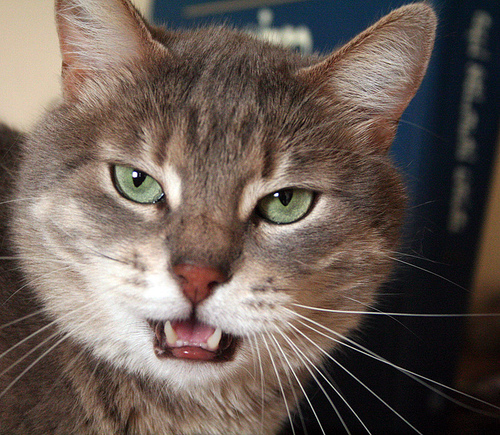
Can You Talk Cat?
Ever wonder what your cat is trying to say to you? Cats use a mixture of verbal and body language communications to interact with their owners and this can be confusing if you are not clued-up on what these sounds and actions can mean.
Understanding Cat Sounds
Cats use body language hints to communicate with each other and as humans are not receptive to this, they have adapted to use a more verbal form of communication to interact with us. Here are some of the most common examples and what they mean.
- Growling – This is usually a sign of anger or aggression and can be used as a warning sign
- Hissing – This is usually a sign of displeasure but can also indicate being scared. It is often used as a tactic to scare away threats such as other cats and can mean that you are being seen in this way
- Short Meow – This is usually meant as a greeting
- Mid Pitch Meow – This is usually indicative of a request (for food or attention, for example)
- Exaggerated Meow – This is usually indicative of a demand that is more forceful than a mid pitch meow request
- Low Pitch Meow – This is a sign that your cat is not happy with a particular situation
Understanding Cat Body Language
While cats do not primarily use body language to communicate with us, we can use this to get a better indication of our pet’s state of mind.
- Straight Up Tail With a Curl – This is usually a sign of happiness
- Twitching Tail – This can indicate excitement or anxiety
- Dilated Pupils – Dilated pupils can signal excitement but there is also the possibility of aggression and fear
- Kneading – Pawing and kneading their owner is a sign of affection and contentment
Communicating With Your Cat
The tone that you use when speaking to your cat can have a big impact on how they react to you. Talking in a slightly raised voice for friendly and positive situations such as greetings is recommended.
When asking your cat not to do something though, it is better to stick to a lower and firmer tone of voice that is markedly different to both your normal speaking voice and your “positive” voice. In time, your cat should come to realise that this tone of voice is a warning sign. It is important not to pet your cat while using this tone of voice, otherwise your actions will be seen as a green light to continue and a negative association will not be formed.
How do you communicate with your cat? Do you understand their verbal and non-verbal clues or is your pet still a mystery to you? Share your experiences in the comments section below!
[Photo Credits: rozroz]